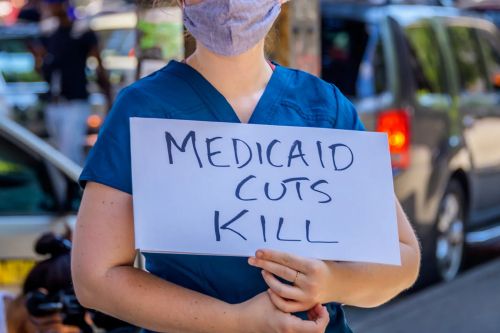

As the 2026 midterms approach, the political question will sharpen: was it worth it? Was the promise of savings worth the cost in lives, in local economies, and in public trust?

By Matthew A. McIntosh
Public Historian
Brewminate
Introduction
The television flickers in the common room of a Colorado nursing home, but most of the residents aren’t watching. They’re gathered around the administrator, who is explaining what Medicaid cuts could mean in the coming months. For many here, Medicaid is not an abstract government program; it’s the reason they have a bed, daily meals, and aides to help them dress and bathe. “Medicaid saved my life,” one resident told CPR News, her voice trembling as she wondered aloud what would happen if her coverage disappeared. Across the state, nursing homes warn that staff could be cut and services scaled back if the reductions go forward, leaving some of the frailest Americans to fend for themselves.
The stakes are not confined to Colorado. In rural Alamosa County, two in five residents depend on Medicaid, and hospital leaders say even modest cuts could push already-strapped facilities over the edge. Nationwide, the Congressional Budget Office projects that nearly 10 million people could lose coverage under the Republican “Big Beautiful Bill,” which imposes tighter eligibility rules and reduces funding streams. That loss of coverage doesn’t just translate into statistics; it means skipped medications, untreated illnesses, and, inevitably, preventable deaths.
For Republicans, the political cost may be mounting alongside the human one. Early polling shows more than half of Americans worry Medicaid cuts will affect their family’s access to care, and swing-district lawmakers are already facing angry constituents. The humanitarian crisis threatens to become a political crisis, one that could reshape the 2026 midterms as voters weigh whether austerity was worth the price in lives.
What the Cuts Entail
Republicans have branded their sweeping budget plan the “Big Beautiful Bill,” but beneath the branding lies one of the most significant reductions to Medicaid in the program’s history. The proposal includes stricter work requirements, shorter retroactive coverage periods, tighter income verification checks, and restrictions on how states can use provider taxes to fund their share of the program. According to the Congressional Budget Office, these changes would leave nearly 10 million people without coverage.
Supporters argue the plan reins in spending, curbs fraud, and restores fiscal discipline. But health economists warn that the projected “savings” may be illusory. When patients lose coverage, they don’t stop needing care. They often delay treatment until conditions worsen, turning manageable illnesses into emergencies. That shift drives people into emergency rooms, the most expensive place in the health system to receive care, creating costs that ripple across hospitals, insurers, and taxpayers.
The Human Stakes
Medicaid is not only for the very poor, as critics sometimes suggest. It insures one in five Americans and funds services ranging from childbirth to chemotherapy to long-term nursing care. For seniors and people with disabilities, Medicaid is the backbone of long-term support. For low-income children, it provides checkups, vaccines, and treatments that shape lifelong health.
Cutting the program, experts note, disproportionately affects groups already struggling with health inequities. Research published in the American Journal of Managed Care warns that the reductions will deepen gaps in access, especially for children, who are most vulnerable to interruptions in coverage. Children who lose Medicaid coverage are far less likely to re-enroll later, leaving them uninsured even as they age into higher-risk stages of life.
The consequences extend far beyond households. Medicaid is the single largest payer for nursing home care in the country. Cuts at that level would leave facilities struggling to keep doors open, forcing families into impossible choices: pay thousands out of pocket or pull loved ones out of professional care altogether.
Local Evidence and Case Studies
Colorado Nursing Homes on the Brink
In Colorado, where Medicaid covers more than 1.5 million residents, the program’s vulnerability is already visible. Nursing home administrators warn that even modest reductions in federal support could trigger staff layoffs, longer wait times, and diminished care. At one facility outside Denver, residents told reporters they feared losing the very services that kept them alive. “Medicaid saved my life,” one elderly woman said flatly, adding that she had nowhere else to go if her coverage disappeared.
Operators are equally blunt. With Medicaid paying for the majority of nursing home stays, cuts at the federal level will almost certainly translate into financial collapse for some providers. “We don’t have the margins to absorb this,” one administrator said. “It’s not just about numbers on a page. It’s about whether our doors stay open.”
Rural Communities as the Canary in the Coal Mine
The impact is especially stark in rural regions. In Alamosa County, Colorado, two in five residents rely on Medicaid for health coverage. Hospitals here operate on razor-thin budgets, and Medicaid reimbursements are a critical lifeline. Any shortfall could push facilities into closure, leaving entire regions without accessible care. As one local health leader explained, “We’re the only hospital for hours. If we can’t make payroll because Medicaid dries up, people will have nowhere to go.”
When rural hospitals shutter, the consequences cascade: jobs vanish, economies shrink, and residents must travel farther for basic care. Pregnant women may find themselves driving hours for prenatal visits; emergencies become life-threatening simply because help is too far away. These ripple effects make Medicaid cuts not just a health crisis but an economic and social one.
Systemic Ripple Effects
The Harvard T.H. Chan School of Public Health has warned that the fallout extends far beyond immediate beneficiaries. Medicaid cuts threaten the financial stability of safety-net providers, urban and rural alike, and risk destabilizing entire state health systems. Meanwhile, public opinion surveys show widespread fear: more than half of Americans worry about their own families’ access to care if federal cuts go through, and 71 percent believe hospitals and nursing homes would be directly endangered.
The Political Dimension
Early Red Flags for Republicans
Even before the cuts take full effect, Republican lawmakers are feeling the heat. In Georgia, where Medicaid covers nearly two million people, the Atlanta Journal-Constitution reported that GOP members are encountering fierce pushback at town halls and campaign stops. Constituents, many of them in rural and swing districts, are demanding answers about why a party that promised to “protect seniors and families” is backing measures that threaten both.
The risk is particularly acute for representatives in districts with high Medicaid enrollment. Nursing homes, hospitals, and community health centers are often among the largest employers in those areas. If services contract or facilities close, the economic and political blowback will be swift. As one political strategist told the AJC, “You can’t campaign on protecting families and then gut the program that keeps those families afloat. Voters notice.”
Public Opinion Turning Sour
Polling data underscores the danger. A national survey from the Kaiser Family Foundation found that more than half of Americans worry Medicaid cuts will directly harm their family’s ability to obtain care, and 71 percent believe the cuts will destabilize hospitals and nursing homes. Among current Medicaid enrollees, concern runs even higher: 86 percent expressed fear about losing coverage. These numbers are not abstract — they translate into political peril for incumbents defending the policy.
The backlash is also visible in swing-state suburbs, where middle-class families who don’t think of themselves as “Medicaid people” nonetheless rely on the program for elderly parents in nursing care or children with disabilities. When those supports are threatened, partisan loyalty can quickly weaken.
GOP Messaging and Defense
Republican leaders, including the Trump administration, insist the cuts are “reforms” designed to preserve Medicaid for those who need it most. They argue that work requirements, tighter verification, and funding limits are about cutting waste, not care. “We’re not taking Medicaid away from seniors or the disabled,” one administration official told Politico. “We’re making sure it’s there for them in the long run.”
But critics counter that these defenses crumble under scrutiny. Work requirements and stricter paperwork don’t weed out “fraudsters” so much as overwhelm vulnerable people with red tape, causing eligible individuals to lose coverage simply because they can’t navigate the bureaucracy. That’s why analysts say the biggest coverage losses will come not from those ineligible for Medicaid, but from those who technically still qualify but can’t clear the new hurdles.
As the debate intensifies, Republicans face a paradox: they may win short-term points for fiscal conservatism with their base, but risk long-term damage in swing districts and among independents who see the cuts as cruel and self-defeating.
The Long-Term Cost: Human, Financial, and Moral
Health Consequences
When people lose Medicaid, they don’t stop getting sick; they simply stop getting treated. Doctors warn that patients who forgo preventive visits or skip medications end up in emergency rooms with advanced conditions that are both harder and more expensive to treat. A child missing routine asthma care can become a pediatric ICU admission. A senior unable to afford insulin may arrive at the ER in diabetic crisis. As one Harvard health policy professor explained, “Cutting Medicaid doesn’t cut illness. It just shifts the cost to the worst possible place, the emergency department.”
Evidence from prior rollbacks underscores the point. States that imposed work requirements in the past saw thousands of eligible people lose coverage due to paperwork errors, not ineligibility. Studies consistently show that losing Medicaid coverage increases mortality rates, with deaths rising from untreated chronic conditions, delayed cancer diagnoses, and preventable infections.
Economic Burden
Hospitals are already sounding alarms about the financial toll. Uncompensated care, when patients show up without insurance, forces hospitals to eat the cost or pass it along to others through higher prices. Rural hospitals, already operating on razor-thin margins, are particularly vulnerable. Closures don’t just eliminate access to care; they devastate local economies, costing hundreds of jobs and removing one of the few stable anchors in many small towns.
The downstream effects extend beyond health care. Poorer health outcomes mean more people out of the workforce, higher disability claims, and greater strain on social safety nets. Ironically, these costs often outstrip whatever “savings” Medicaid cuts were supposed to achieve. “You can’t squeeze blood from a stone,” said one hospital administrator in Colorado. “When Medicaid disappears, the costs don’t vanish; they just show up somewhere else.”
Moral and Equity Implications
At its core, the Medicaid fight is also about moral priorities. Cuts fall hardest on those with the fewest resources: children, people with disabilities, low-income families, and communities of color. Critics argue this is not just bad policy but a betrayal of national values. The U.S. is one of the wealthiest countries in the world, yet millions of its citizens face the prospect of losing access to life-saving care in the name of austerity.
Religious leaders, patient advocates, and medical associations have framed the debate in humanitarian terms: denying care to the vulnerable is not only fiscally reckless but morally indefensible. “Medicaid is the safety net that keeps people alive,” one advocacy group stated bluntly. “When we cut it, people die.”
Potential Counters and Caveats
Supporters of the cuts insist that critics are overstating the threat. Republican lawmakers argue the changes are about trimming waste, enforcing accountability, and ensuring Medicaid remains solvent for those who “truly need it.” Work requirements, they say, encourage employment and self-reliance. Tighter eligibility checks, in their framing, prevent fraud and preserve funds for the most vulnerable.
Some states may also try to blunt the impact. Governors in a handful of states have floated plans to use state dollars or policy workarounds to sustain coverage if federal funding recedes. But not all states have the fiscal room or political will to do so. The result could be a patchwork America where Medicaid’s promise depends heavily on your ZIP code.
Legal battles are another wild card. Just this month, a federal judge struck down a Centers for Medicare and Medicaid Services rule that would have limited states’ ability to raise money through provider taxes, following a challenge from Texas. Similar lawsuits could delay or even block aspects of the cuts, buying time for states and patients, though not necessarily altering the underlying intent.
Still, analysts caution that these caveats don’t negate the central reality: millions stand to lose coverage, and the burden will fall most heavily on those least able to bear it.
Conclusion / Call to Watch
The Medicaid fight is no longer theoretical. Nursing homes in Colorado are warning residents about service cuts. Rural hospitals are bracing for the possibility of closure. Parents are fearing what will happen if their children lose access to routine care. Behind every budget line is a human life, and those lives are already being shaken by the uncertainty.
Republicans may have won applause from their base for promising fiscal discipline, but the backlash shows signs of spreading beyond partisan lines. Polling suggests Americans are more worried about protecting access to care than trimming the federal budget, and lawmakers in vulnerable districts are starting to feel the squeeze.
As the 2026 midterms approach, the political question will sharpen: was it worth it? Was the promise of savings worth the cost in lives, in local economies, and in public trust? The humanitarian crisis is real. The political crisis may only just be beginning.
Originally published by Brewminate, 09.30.2025, under the terms of a Creative Commons Attribution-NonCommercial-NoDerivatives 4.0 International license.


